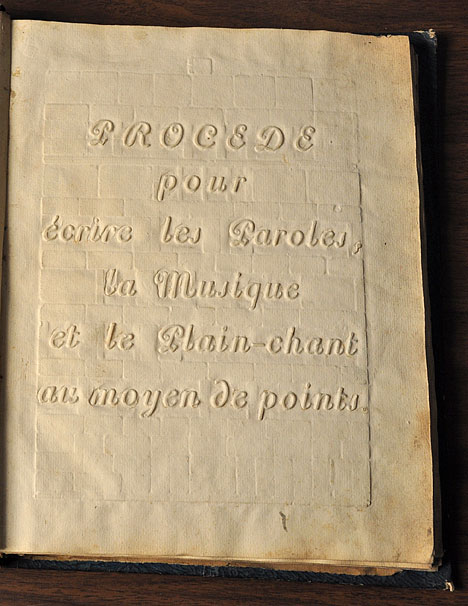
This is a copy of this wonderful material prepared by the NFB. Here is the source. It is collected here is case of network issues.

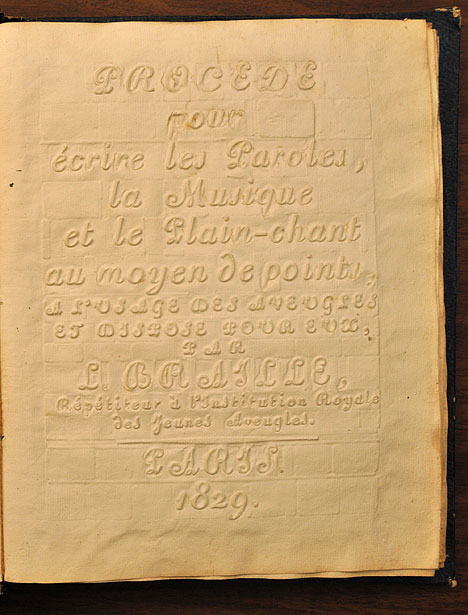
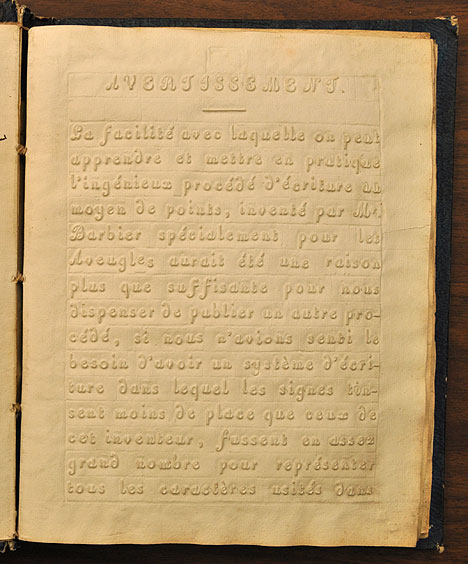
La facilité avec laquelle on peut apprendre et mettre pratique l’ingénieux procédé d’écriture au moyen de points, inventé par Mr. Barbier spécialement pour les Aveugles aurait été une raison plus que suffisante pour nous dispenser de publier un autre procédé, si nous n’avions senti le besoin d’avoir un système d’écriture dans lequel les signes tinsent moins de place que ceux de cet inventeur, fussent en assez grand nombre pour représenter tous les caractère usités dans
The ease with which one can learn and put into practice the ingenious procedure for writing with dots, invented by Mr. Barbier especially for the blind, would have been more than enough reason for us to dispense with publishing an alternative procedure, if we hadn’t felt the need for a writing system in which the signs take less room than those of Mr. Barbier, were of sufficient number to represent all the characters in
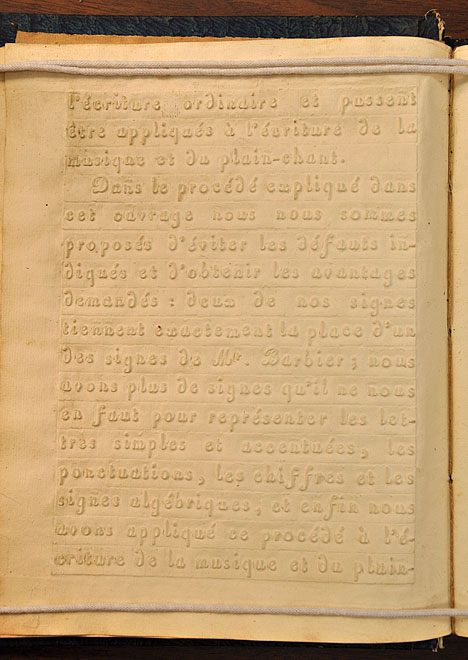
l’écriture ordinaire et pussent être appliqués à l’écriture de la musique et du plain-chant.
Dans le procédé expliqué dans cet ouvrage nous nous sommes proposés d’éviter les défauts indiquer et d’obtenir les avantages demandés: deux de nos signes tiennent exactement la place d’un des signes de Mr. Barbier; nous avons plus de signes qu’il ne nous en faut pour représenter les lettres simples et accentuées, les ponctuations, les chiffres et les signes algébriques, et enfin nous avons appliqué ce procédé à l’écriture de la musique et du plain-
ordinary writing, and could be applied to music and plainsong.
In the procedure described in this work we have in mind avoiding the faults and obtaining the needed advantages: two of our signs take exactly the same amount of space as one of Mr. Barbier’s. We have more signs than are needed to represented simple and accented letters, punctuation signs, numbers and algebraic signs, and finally we have applied this procedure to writing music and plain-
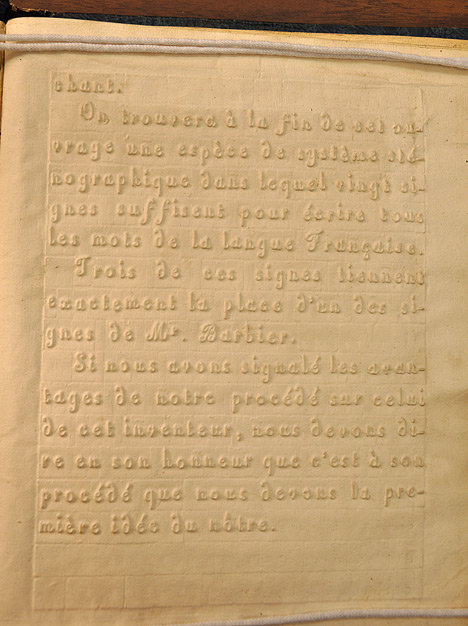
chant.
On trouvera à la fin de cet ouvrage une espèce de système sténographique dans lequel vingt signes suffisent pour écrire tour les mots de la langue Française.
Trois de ces signes tiennent exactement la place d’un des signes de Mr. Barbier.
Si nous avons signalé les avantages de notre procédé sur celui de cet inventeur, nous devons dire en son honneur que c’est à son procédé que nous devons la première idée de nôtre.
song.
At the end of this work is a type of stenographic system in which twenty signs suffice for writing every word in the French language.
Three of these signs take exactly the same amount of space as one of Mr. Barbier’s.
If we have made much of the advantages of our procedure over that of Mr. Barbier, we must say in his honor that it is to his procedure that we owe the germ of the idea of our own.

Ce procédé repose sur la connaissance de dix signes qui résultent de la combinaison de deux rangées de points composées chacune d’un ou de deux points, disposes parallèlement entre’elles et placées verticalement sur le papier.
On entend par première rangée
This procedure depends on familiarity with ten signs that result from combining two columns, each composed of one or two dots, arranged parallel to each other and placed vertically on the paper
We will call the first column

de points celle des deux rangées qui se trouve placé à la gauche de l’autre, et par seconde rangée, celle qui et placé à la droite de la première.
On appelle partie supérieure d’une rangée ou d’un signe la partie de cette range ou de ce signe qui est la plus éloignée de l’écrivain ou du lecteur, et on appelle partie inferieure celle qui en est la plus proche.
Chaque signe est essentiellement composé de deux rangées de points ou de la place de ces rangées. Si dans l’explication que nous allons donner de chaque si-
the one that is to the left of the other, and the second column the one that is to the right of the first.
We will call the upper position in a column or a sign the part of that column or sign that is furthest from the writer or reader, and we will call the lower position that which is the closest.
Each sign is composed essentially of two columns of dots or the spaces they would occupy. If in the explanation that we are about to provide of each sign

gne nous ne parlons quelquefois que d’une rangée ou que d’une partie de rangée c’est parce que la rangée ou la partie de rangée dont nous ne faisons point mention doit rester vide.
Voici la formation des dix signes fondamentaux.*
Le premier signe est représenté par un point
placé à la partie supérieure de la première rangée; le second par un point à
chaque partie de la première
___________________
*Voyez une autre explication des dix signes fondamentaux à la fin
de l’ouvrage.
song.
At the end of this work is a type of stenographic system in which twenty signs suffice for writing every word in the French language.
Three of these signs take exactly the same amount of space as one of Mr. Barbier’s.
If we have made much of the advantages of our procedure over that of Mr. Barbier, we must say in his honor that it is to his procedure that we owe the germ of the idea of our own.
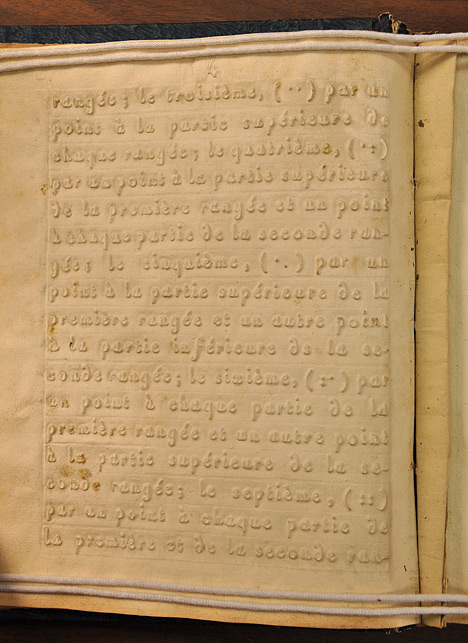
rangée; le troisième, par un point à la partie supérieure de chaque rangée; le quatrième, par un point á la partie supérieure de la première rangée et un point à chaque partie de la seconde rangée; le cinquième, par un point a la partie supérieure de la première rangée et un autre point á la partie inférieure de la seconde rangée; le sixième, par un point à chaque partie de la première rangée et un autre point à la partie supérieure de la seconde rangée; le septième, par un point a chaque partie de la première et de la seconde ran-
column; the third, by a dot in the upper position of each column; the fourth, by a dot in the upper position of the first column and both positions of the second column; the fifth, by a dot in upper position of the first column and another in the lower position of the second column; the sixth, by a dot in each position of the first column and another in the upper position of the second column; the seventh, by a dot in each position of both columns;

gée; la huitième, par un point a chaque partie de la première rangée et autre point à la partie inférieure de la second rangée; le neuvième, par un point à partie inférieure de la première rangée et un autre point à la partie supérieure de la seconde rangée; le dixième, par un point a la partie inférieure de la première rangée et un autre point à chaque partie de la seconde rangée. Voyez le tableau ci-après.
the eighth, by a dot in each position of the first column and another in the lower position of the second column; the ninth, by a dot in the lower position of the first column and another in the upper position in the second column; the tenth, by a dot in the lower position of the first column and another in each position of the second column. Look at the following table.
[Here Braille provides a graphic with each of the ten signs, numbered 1 through 10. Braille readers will recognize these as the first ten letters of the alphabet, a through j]

En combinant les signes dont nous venons de donner les tableaux avec un point, deux points ou un trait horizontal on obtient neuf séries de signes composées chacune des dix signes fondamentaux à chacun desquels on ajoute une des trois chose mentionnées.
Voici l’application des neuf séries.
La première série est composée des dix signes fondamentaux; la seconde est marquée par un point placé au-dessous de la partie inférieure de la première rangée de chaque signe; la troisième par un point placé au-dessous de
When combining the signs that we have just illustrated in the table with one or two dots, or a dash, we get nine series of signs each of which is composed of the ten fundamental signs with one of these three things added to it.
Here is how to create the nine series.
The first series is composed of the ten fundamental signs; the second is denoted by a dot placed below the lower position of the first column of each sign; the third by a dot placed below

la partie inférieure de chaque rangée; la quatrième par un point placé au-dessous de la partie inférieure de la seconde rangée. Les signes de la cinquième série exigent chacun une explication particulière; nous expliquerons cette série après les quatre dernières. La sixième série se marquée par un trait horizontal placé au-dessous de la partie inférieure de chaque signe; la septième, par un trait horizontal place au dessous de la partie supérieure de chaque signe. On observera qu’au premier et au troisième signe fondamental qui devraient entrer dans la compo-
the lower position of each column; the fourth by a dot placed below the lower position of the second column. The signs of the fifth series require a special explanation; we will explain this series after the final four. The sixth series is composed of a dash placed below the lower position of each sign; the seventh by a dash placed below the upper position of each sign. It should be evident that for the first and the third fundamental signs which are supposed to be part of the

sition du premier et du troisième signe de cette série et de la suivante, il faut substituer au premier un signe formé par un point a la partie inférieure de la première rangée, et au troisième, un signe formé par un point à la partie inférieure de chaque rangée. La huitième série se marque par un trait place entre les deux partie de chaque signe; la neuvième, par un trait place au-dessous de chaque signe de la cinquième série. Les signes de la cinquième série reposent sure un principe étranger au reste du procédé; voici la formation de chacun de
first and third signs of this and the following series, it will be necessary to substitute for the first, a sign formed by a dot in lower position of the first column, and for the third, a sign formed by a dot placed in the lower position of each column. The eighth series is marked by a dash placed between the two parts of each sign; the ninth by a dash placed below each sign of the fifth series. The signs of the fifth series rest on a principle foreign to the rest of the procedure; here is how to form each of

ces signes.
Le premier signe est représenté par un trait place a la partie supérieure de chaque signe; le second, par un trait à la partie supérieure du signe et un autre trait à la partie inférieure du même signe; le troisième, par un trait à la partie supérieure du signe et un point à la partie inférieure de la première rangée; le quatrième, par un trait à la partie supérieure du signe et un point à la partie inférieure de chaque rangée; le cinquième, par un trait à la partie supérieure du signe et un point à la partie inférieure de la seconde
these signs.
The first is represented by a dash placed in the upper position of the sign; the second by a dash in the upper position of the sign and another dash in the lower position of the same sign; the third, by a dash in the upper position of the sign and a dot in the lower position of the first column; the fourth, by a dash in the upper position of the sign and a dot in the lower position of each column; the fifth, by a dash in the upper position of the sign and dot in the lower position of the second

rangée; le sixième, par un point à la partie
supérieure de la première rangée et un trait a la partie inférieure du signe;
le septième, par un point à la partie supérieure de chaque rangée et un trait
à la partie inférieure du signe; le huitième, par un point à la partie
supérieure de la seconde rangée et un trait à la partie inférieure du signe;
le neuvième, par un point à la partie supérieure de la seconde rangée; le
dixième, par un point à chaque partie de la second rangée.*
______________________
* Voyez une autre explication
column; the sixth, by a dot in the upper position of the first column and a
dash in the lower position of the sign; the seventh, by a dot in the upper
position of each column and a dash in the lower position of the sign; the
eighth, by a dot in the upper position of the second column and a dash in the
lower position of the sign; the ninth, by a dot in the upper position of the
second column; the tenth, by a dot in each position in the second column*
______________________________________
*See another explanation

Voici l’explication des six signes
supplémentaire; le premier de ces signes est marquée par un point au-dessous
de la première rangée; le second par un point au-dessous de chaque rangée; le
troisième par un point a chaque partie de la second rangée et par un point
au-dessous de la première rangée; le quatrième, par un point placé à chaque
partie de la second rangée et un autre point au-dessous de chaque rangée; le
cinquième, par un trait à
_____________________
des signes de la
cinquième série a la fin de l’ouvrage
Here is the explanation of the six supplementary signs; the first of these
signs is marked by a dot below the first column; the second by a dot below each
column; the third by a dot in each position in the second column and a dot
below the first column; the fourth, by a dot placed in each position of the
second column and another below each column; the fifth, by a dash in
______________________________
of the signs of the fifth series at the end
of this work.
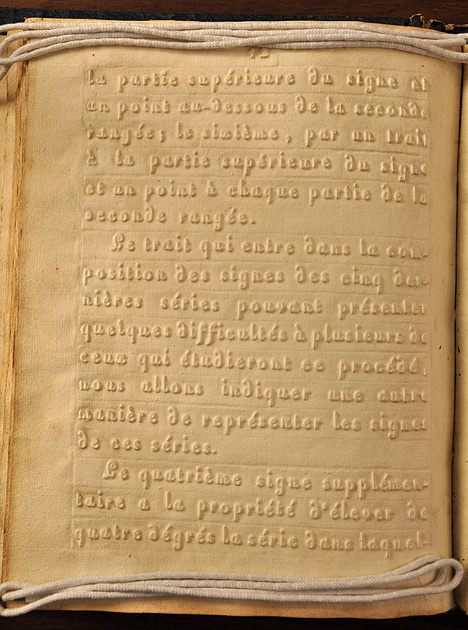
la partie supérieure du signe et un point au-dessous de la seconde rangée; le sixième, par un trait a la partie supérieure du signe et un point a chaque partie de la second rangée.
Le trait qui entre dans le composition des signes des cinq dernières séries pouvant présenter quelques difficultés a plusieurs de ceux qui étudieront ce procédé; nous allons indiquer une autre manière de représenter les signes de ces séries.
Le quatrième signe supplémentaire a la propriété d’élever de quatre degrés la série dans lequel-
the upper position of the sign and a dot below the second column; the sixth, by a dash in the upper position of the sign and a dot in each position of the second column.
The dash that enters into the composition of the five final series can present some difficulty to many of those who will study this procedure; we are going to indicate another way of representing the signs of this series.
The fourth supplementary sign has the property of the property of raising to four degrees the series

le se trouve le signe qui en est précédé; ainsi si le quatrième signe supplémentaire se trouve devant le second signe de la troisième série, le second signe de cette troisième série ne devra être considéré comme tel parce qu’il devient alors le second signe de la septième.
Nous allons offrir le tableau des signes et des lettres, de manière que chaque lettre se trouve au-dessous du signe qui doit le représenter.
Voyez le tableau ci-joint.
of the sign it precedes; thus if the fourth supplementary sign is found before the second sign of the third series, it becomes the second sign of the seventh.
We are going to offer a table of the signs of the letters, in which each letter is found below the sign that represents it.
See the attached table

[«Tableau des signes des neuf séries, avec les lettres, les chiffres, les signes de ponctuation les signes algébriques qui leur correspondent»]
[Here Braille starts a “Table of the signs of the nine series, with the letters, the numbers, the punctuation signs and the algebraic signs that correspond to them”]

[Continuation of the “Table of the signs of the nine series, with the letters, the numbers, the punctuation signs and the algebraic signs that correspond to them”]

[Continuation of the “Table of the signs of the nine series, with the letters, the numbers, the punctuation signs and the algebraic signs that correspond to them”]

Nous avons aussi appliqué ce procédé à l’écriture de la Musique, en substituant aux lettres et aux caractères employés dans le système usité à l’Institution, les signes qui leur correspondent dans les six premières séries du tableau précédent.
Nous avons seulement changé la manière de marquer les valeurs et les notes accidentels.
Les valeurs, savoir: la Ronde, la Blanche, la Noire, la Croche, la Double, la Triple, et la Quadruple Croche, sont représentées par les sept premières signes de la septième série, c’est-à-
We have also applied this procedure to writing music, by substituting for the letters and characters employed in the system used in the Institution for Blind Youth, the signs that correspond to them in the six first series of the preceding tables.
We have only changed the way of indicating the durations and the accidental notes.
The durations, to wit: the whole note, the half note, the quarter note, the eighth note, the sixteenth, the thirty-second, and the sixty-fourth note, are represented by the first seven signs of the seventh series, which is to

dire que le premier signe de cette série indique la Ronde; le second la Blanche; ainsi de suite.
Le Dièse est représenté par le huitième signe de la septième série; le Bémol par le neuvième signe de cette série et le Bécarre par le dixième.
Nous avons encore simplifié ce procédé pour l'écriture de la musique peu compliquée; tel que le plain-chant.
Les notes sont représentées par les dix signes de la première série du tableau précédent, et par le neuvième et le dixième signe de la cinquième série.
say that the first sign of the series indicate the whole note, the second the half note, and so on.
The sharp is represented by the eighth sign of the seventh series; the flat by the ninth sign of this series and the natural by the tenth.
We have yet further simplified this procedure for less complicated music; such as plainsong.
The notes are represented by the ten signs of the first series of the preceding table, and by the ninth and tenth sign of the fifth series.

Les valeurs se marquent de cette manière*: la
Ronde se marque par un trait placé au-dessus du signe qui représente la note;
la Ronde pointée, par un trait
____________________________________
*Quoique dans le plain-chant les valeurs ne portent pas les même noms que dans
la musique ordinaire et que dans ces deux choses elles ne se correspondent pas
exactement, nous nous sommes cependant servis des termes usités en musique
pour ces valeurs; les valeurs de plain-chant sont: la Double Quarrée qui
correspond à la Ronde; la Quarrée, à la Blanche;
The durations are indicated in this way*: the whole note by a dash placed
above the sign that represents the note; the dotted whole note, by a dash
____________________________________
*Although in plainsong the durations
do not carry the same name as in ordinary music, and although in these two
things they do not correspond exactly, we have nonetheless made use of the
terms used in music for these durations; the durations of plainsong are: the
double square which corresponds to the whole note; the square, to the
half-note;

entre les deux partie du signe (pour les notes
affectées de l’une de ces valeurs on fera la substitution indiquée pour le
premier et le troisième de la septième et la huitième série; et au lieu du
onzième signe, on mettra un point placé à la partie inferieur de la seconde
rangée.) La Blanche est représentée par la vide qui se trouve au-dessous du
signe; la Blanche pointée, par
______________________
la Longue, à la
Blanche pointée ou à la Noire pointée; la Brève sans queue, à la Noire; et la
Brève à queue, à la Croche.
between the two parts of the sign (for notes affected by one of these
durations one makes the substitution indicated for the first and the third of
the seventh and the eighth series; and in place of the eleventh sign, one puts a
dot placed at the lower part of the second column). The half note is
represented by an empty place below the sign; the dotted half note, by
______________________
the long, to the dotted half note or the dotted
quarter note, the breve with no tail, to the quarter note; and the breve with
tail, to the eighth note.

un trait au-dessous du signe; la Noire, par un point au-dessous de la première rangée; la Noire pointée, par un point au-dessous de chaque rangée; la Croche, par un point au-dessous de la seconde rangée.
Les clefs dans le plain-chant se marquent de la manière suivante: la clef d’Ut, par le cinquième signe de la cinquième série; la clef de Fa, par le sixième signe de cette série; la clef de Sol, par le septième; et la clef de La, par le huitième signe de la même série.
Le nombre de Dièses ou de Bé-
a dash below the sign; the quarter-note, by a dot below the first column; the dotted quarter-note by a dot below each column; the eighth note by a dot below the second column.
Clefs in plainsong are indicated as follows: the alto clef, by the fifth sign of the fifth series; the bass clef, by the sixth sign of this series; the treble clef, by the seventh; and the tenor clef, the eighth sign of the same series.
The number of sharps or flats

mols qui doivent être à la clef se marque par un des signes de la cinquième série suivi par d’une des lettres d ou b, suivant qu’on veut indiquer des Dièses ou des Bémols.
On indique l’altération d’une note de la manière suivante: la note accidentellement dièse et précédée d’un signe formé par un point placé à la partie inférieure de la seconde rangée qui forment chaque signe; la note bémol est précédée d’un signe formé par un point placé à la partie inférieure de chacune des rangées qui forment un si-
that should be at the clef are indicated by one of the signs of the fifth series followed by one of the letters “d” or “b”, depending on whether one wishes to indicate sharps or flats.
One indicates alteration of a note in the following manner: the note made sharp is preceded by a sign formed by a dot placed in the lower part of the second column that forms each sign; a flat is preceded by a sign formed by a dot placed in the lower part of each of the columns that form a sign;

gne; et la note bécarre et précédée d’un signe formé par un trait placé à la partie inférieure du signe.
La barre de reprise se marque par le premier signe supplémentaire; et l’étoile par le second signe supplémentaire.
On voit par tout ce que nous avons dit qu’un même signe peut représenter une lettre, un Caractère de Musique et un Note de plain-chant; pour éviter la confusion qui pourrait résulter de triple emploie de chaque signe on fera précéder les paroles du premier signe de la neuvième sé-
and a natural is preceded by a sign formed by a dash placed in the lower part of the sign.
The repeat sign is indicated by the first supplementary sign; and the star by the second supplementary sign.
One sees from all that we have said that the same sign can represent a letter, a musical note and a note in plain song; to avoid the confusion that can result from the triple use of each sign, one can precede words with the first sign of the ninth

rie; la musique, du second signe; et le plain-chant, du troisième signe de cette même série. Il sera bon aussi de mettre au commencement de chaque page le signe de celle de ces trois choses qui s’y trouve.
Lire et écrire selon le procédé que nous venons d’indiquer sont deux choses qui exigent deux habitudes bien distinctes; car en marquant des points sur le papier ils reparaissent du coté opposé; et si par exemple on écrit deux signes de manière que l’on soit à la droite de l’autre, il faudra retourner le papier pour voir ce qui
series; music with the second sign; and plain song, with the third sign of this same series. It will also be good to put at the start of each page the sign of which of the three things are found there.
Reading and writing according to this procedure require two distinct types of practice; since in making dots on paper they appear on the other side; and if for example one writes two signs such that the first is to the right of the second, it would be necessary to turn the paper over to see what

a été écrit; le signe qui en écrivant, se trouvait à la droit de l’autre, se trouvera alors à la gauche, et la première rangée de chaque signe, qui se trouvait à la gauche de la seconde, se trouverais à la droite de celle-ci.
Pour lire de gauche à droite il faudra donc écrire de droite à gauche, et pour que la première rangée de chaque signe se trouve à la gauche de la seconde rangée en lisant, it faudra la placée á la droite de celle-ci en écrivant.
La planchette grillée dont nous nous servons pour écrire ne diffère de celle de Mr. Barbier
had been written; the sign which in being written, was to the right of the other, will be found then at the left, and the first column of each sign, which was to the left of the second, will be found to the right.
To read from left to right it will be necessary therefore to write from right to left, and so that the first column of each sign is to the left of the second while reading, it will be necessary to place it to the right while writing.
The grated board which serves us for writing differs from that of Mr. Barbier only

qu’en ce que celle-ci a six lignes concaves à la surface, tandis que la nôtre n’en a que trois.
On place la planchette dans une direction horizontale par rapport à l’écrivain; on introduit ensuite le papier entre cette planchette et la grille qui la recouvre de manière que si le papier excède la largeur de la planchette l’excédant se trouve de la côté de l’écrivain.
L’intérieur de chaque rectangle de la grille peut renfermer un signe: la première rangée du signe se marque en faisant glisser le stylet contre le côté droit du
in that his has six concave lines on the surface, while ours has but three.
Place the board in a horizontal direction in relation to the writer; then place the paper between this board and the grating which covers it in such a manner that if the paper is wider than the board, the excess faces the writer.
The interior of each rectangle of the grating can enclose one sign: the first column of the sign is made by sliding the stylus along the right side of

rectangle, et la seconde se marque en faisant glisser le stylet contre le côté gauche de même rectangle. Le premier signe se fait dans le rectangle qui est le plus sur la droite de la planche; le second signe se fait dans le rectangle qui est à la gauche du premier; le troisième dans le rectangle qui est à la gauche du second, et ainsi de suite.
Lorsque le stylet a ainsi passé dans tous les rectangles de la grille, la première ligne est achevée; on fait ensuite glisser le papier vers la partie supérieure de la planchette pour que la ligne
the rectangle, and the second is made by sliding the stylus along the left side of the same rectangle. The first sign is made in the rectangle that is the furthest right on the board; the second is made in the rectangle that is to the left of the first; the third in the rectangle to the left of the second, and so on.
When the stylus has thus passed through all the rectangles of the grating, the first line is finished; one then moves the paper toward the upper part of the board, so that the written

écrite ne se trouve plus entre cette planchette et la grille, et on écrit la seconde ligne comme la première; il en est la même pour toutes les autres.
line is no longer between the board and the grating, and one writes the second line like the first; it is the same for each of the others.

Si nous représentons par a, le point à la partie supérieure de la première rangée; par b, le point à la partie inférieure de la même rangée; par c, le point à la partie supérieure de la second rangée; par d, le point à la partie inférieure de la même rangée: chaque signe sera formé comme dans le tableau suivant.
If we represent by “a” the dot in the upper position of the first column; by “b,” the dot in the lower position of the same column; by “c,” the dot in the upper position of the second column; by “d,” the dot in the lower position of the same column, each sign will be formed as in the following table.
| 1 | 2 | 3 | 4 | 5 | 6 | 7 | 8 | 9 | 10 |
|---|---|---|---|---|---|---|---|---|---|
| a | ab | ac | acd | ad | abc | abcd | abd | ac | acd |

Si nous représentons chacun des point qui formé un par une des lettres a, b, c, d, et si nous indiquons par f, le trait à la parti supérieure du signe et, par g, le trait à la partie inferieure signe : chaque signe de la cinquième série sera formé comme dans le tableau suivant.
If we represent each of the dots by one of the letters a, b, c, d, and if we represent by “f”, a dash at the top of the sign and, by “g,” a dash at the bottom of the sign: each sign of the fifth series will be formed in the following table.
| 1 | 2 | 3 | 4 | 5 | 6 | 7 | 8 | 9 | 10 |
|---|---|---|---|---|---|---|---|---|---|
| f | fg | fb | fbd | fd | ag | acg | cg | c | cd |

Les sons et les articulations qui forment les mots dans la langue française peuvent être représenté par vingt signes seulement, pourvu que l’on emploie le même caractère pour indiquer les sons presque semblable, tells que u et ou; et les articulations peu différentes comme b et p.
Les lettres qui représentent ces sons et ces articulations sont marquées par les signes de la première et la cinquième série.
Voyez le tableau suivant.
The vowels and consonants that form words in the French language may be represented by twenty signs provided one uses the same character to indicate sounds that are almost the same, such as “u” and “ou”; and the consonants that are little different, such as “b” and “p.”
The letters that represent these vowels and consonants are indicated by the signs of the first and fifth series.
See the following table

TABLEAU des signes de la première et de la cinquième série avec les lettres qui leur correspondent dans notre Système sténographique
TABLE of the signs of the first and fifth series with the letters that correspond to them in our stenographic system
[Here Braille aligns the ten signs of the first series with the vowel sounds in French (not the letters but the sounds): a; é or è; i; o; u or ou; an; in or un; on; eu; oi. He then aligns the ten signs of the fifth series with the sounds of the consonants: b or p; d or t; g or q; j or ch; v or f; z or s; l; m; n; r]